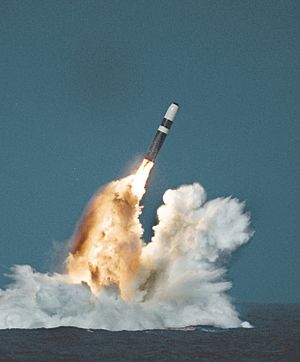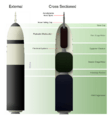Intercontinental ballistic missile facts for kids
An ICBM is a very powerful type of missile. The letters stand for Intercontinental Ballistic Missile. "Intercontinental" means it can travel a super long way, from one continent to another! These missiles are designed to carry a special package called a warhead. Most of the time today, this warhead is a nuclear weapon, which is an incredibly powerful bomb. ICBMs are guided missiles that follow a specific path and can travel more than 5,500 kilometers (about 3,400 miles). While they are mostly made for nuclear weapons, they could also carry chemical or biological weapons.
Contents
What is an ICBM?
An ICBM is a type of ballistic missile. This means it flies high into space, then falls back down to Earth towards its target. Think of throwing a ball really high; it goes up and then comes down. An ICBM does something similar, but on a much bigger scale.
How Far Can They Go?
The "intercontinental" part is key. These missiles can travel huge distances, usually over 5,500 kilometers (about 3,400 miles). This allows them to be launched from one part of the world and reach a target on a different continent.
What Do They Carry?
ICBMs are built to carry a "payload" or "warhead." In modern times, this is almost always a nuclear weapon. A nuclear warhead is an extremely powerful bomb. Sometimes, one missile can even carry several warheads, each aimed at a different target.
How ICBMs Work
ICBMs are complex machines. They use powerful rockets to launch into space.
Launching an ICBM
ICBMs can be launched in a few ways:
- From underground silos: These are strong, deep holes in the ground where the missile is stored safely.
- From special trucks: Some ICBMs can be moved around on large trucks called transporter erector launchers (TELs). This makes them harder to find.
- From submarines: Some missiles are designed to be launched from submarines hidden deep underwater. These are often called SLBMs (Submarine-Launched Ballistic Missiles).
The Flight Path
Once launched, an ICBM goes through several stages:
- Boost phase: The rockets fire, pushing the missile high into the sky and out of Earth's atmosphere.
- Mid-course phase: The missile travels through space, following a curved path. This is where it might release multiple warheads.
- Terminal phase: The warheads re-enter Earth's atmosphere and fall towards their targets at very high speeds.
History of ICBMs
The idea of long-range missiles began during World War II. However, true ICBMs were developed during the Cold War. This was a time when the United States and the Soviet Union were in a race to build the most powerful weapons.
Early Development
The first ICBMs were developed in the 1950s. Countries wanted missiles that could reach an enemy far away without needing planes. The SM-65 Atlas was one of the first US ICBMs, launched in 1957.
The Cold War Race
During the Cold War, both the US and the Soviet Union built many ICBMs. This created a situation called "mutually assured destruction" (MAD). It meant that if one side attacked with nuclear weapons, the other side could also attack back, leading to massive destruction for everyone. This idea helped prevent a full-scale nuclear war.
Modern ICBMs
Today, several countries have ICBMs. They are still seen as a very important part of a country's defense. Modern ICBMs are very accurate and can carry multiple warheads.
Images for kids
-
A 1965 graph showing how NASA's use of ICBM boosters for space missions helped show how reliable these missiles could be.
-
Testing the Peacekeeper's re-entry vehicles. Each line shows the power of about 300 kilotons of TNT, much bigger than the bomb used in Hiroshima.
-
India's Agni-V ICBM being launched from Abdul Kalam Island.
See also
 In Spanish: Misil balístico intercontinental para niños
In Spanish: Misil balístico intercontinental para niños













